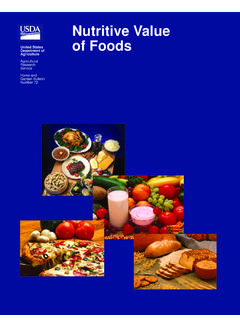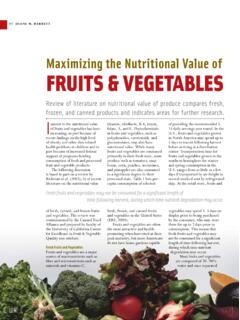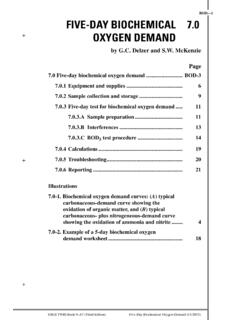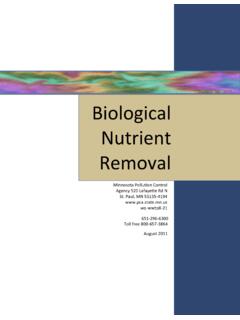Transcription of Animal Diets and Feed Management
1 Animal Diets and Feed ManagementNutrient Management Technical Note No. 8 January 2012 United States Department of AgricultureNatural Resources Conservation ServiceJanuary 2012 The Department of Agriculture (USDA) prohibits discrimination in all its programs and activities on the basis of race, color, national origin, age, disability, and where applicable, sex, marital status, familial status, parental status, religion, sexual orientation, genetic information, political beliefs, re-prisal, or because all or a part of an individual s income is derived from any public assistance program. (Not all prohibited bases apply to all programs.) Persons with disabilities who require alternative means for communication of program information (Braille, large print, audiotape, etc.)
2 Should con-tact USDA s TARGET Center at (202) 720 2600 (voice and TDD). To file a complaint of discrimination, write to USDA, Director, Office of Civil Rights, 1400 Independence Avenue, SW., Washington, DC 20250 9410, or call (800) 795 3272 (voice) or (202) 720 6382 (TDD). USDA is an equal opportunity provider and Management Technical Note No. 8, January 2012 Cover photo: Dairy cows feeding in California. Photo courtesy of NRCS. AcknowledgmentsThis technical note outlines the findings from a Conservation Innovation Grant study conducted by Alan Sutton, , Purdue University, West Lafayette, Indiana; Joe Harrison, , Washington State University, Pull-man, Washington; Rebecca White, Pennsylvania State University, Univer-sity Park, Pennsylvania; Galen Erickson, , University of Nebraska, Lincoln, Nebraska; Todd Applegate, , Purdue University, West Lafay-ette, Indiana; and Robert Burns, , University of Tennessee, Knoxville, Tennessee.
3 Funding for this study was provided by the Department of Agriculture (USDA) Natural Resources Conservation Service (NRCS).This technical note was developed under the direction of Glenn H. Carpen-ter, , National Leader, Animal Husbandry, Ecological Sciences Division (ESD), Washington, DC., and reviewed by William Boyd, Leader, Animal Waste Utilization Team, East National Technology Support Center (ENTSC), Greensboro, North Carolina; Darren Hickman, National Environmental Engineer, Conservation Engineering Division (CED), Washington, DC.; Karen Hoffman, Resource Conservationist Animal Science, Norwich, New York; Cherie Lafleur, Environmental Engineer, Central National Technol-ogy Support Center (CNTSC), Fort Worth, Texas; William Reck, Environ-mental Engineer, ENTSC, Greensboro, North Carolina; Dennis Thompson, National Range and Grazing Land Ecologist, ESD, Washington, DC.
4 nutrient Management Technical Note No. 8, January 2012 nutrient Management Technical Note No. 8, January 2012 This page intentionally left blank. nutrient Management Technical Note No. 8, January 2012 Animal Diets and Feed ManagementIntroductionFeed Management is managing the quantity of nutri-ents fed to livestock and poultry for their intended purpose. This involves development of Diets that supply the quantity of available nutrients required by livestock and poultry for maintenance, production, performance, and reproduction. Supplying nutrients in excess of an Animal s requirement results in additional nutrients being excreted. In many circumstances, confined livestock and poultry operations find them-selves under a whole-farm nutrient imbalance. In this scenario, there are more nutrients being imported on the farm than is being exported from the farm or utilized by current cropping rotations.
5 As a result, soil saturation with various nutrients, especially phospho-rus (P), or excess losses of nitrogen (N), can have a deleterious impact on the environment through runoff, soil erosion, and leaching. Phosphorus losses from soil emptying into surrounding fresh water bodies can lead to eutrophication (Carpenter et al. 1998; Correll 1999; Sharpley et al. 1994). Nitrate leaching from soil into drinking waters can lead to fatalities in humans (Cam-eron et al. 1996) and livestock (Rasby et al. 1988). An-aerobic degradation of manure or other organic matter sources ( Animal mortality, spoiled feed) from the op-eration can cause air quality pollution from the emis-sion of ammonia and other nitrogenous compounds, sulfurous compounds, volatile organic compounds that often are odorous, and can cause greenhouse gas (GHG) and acid rain NRCS Conservation Practice Standard (CPS) Code 592, Feed Management , was developed with the purpose of supplying the quantity of available nutrients required by livestock and poultry for main-tenance, production, performance, and reproduction, while reducing the quantity of nutrients, especially N and P, excreted in manure by minimizing the overfeed-ing of these and other nutrients.
6 As a result of fulfilling this purpose, the livestock and poultry operations can improve the whole-farm nutrient balance and minimize the threat of nutrients from manure impacting water and air quality. In addition, using proper feed manage-ment practices may improve net-farm income by feed-ing nutrients more efficiently. The aim of this technical note is to outline various aspects of Animal nutrition, feed formulation, and feed Management practices to enhance nutrient efficiency, reduce nutrient excretion, and potentially improve net income from livestock and poultry farms. This document presents general back-ground information about Animal nutrition and feed Management of nutrition and feed Management termsNutrition termsNutrient any chemical element or compound in the diet that supports reproduction, growth, lactation, or maintenance-of-life processes.
7 Six classes of nutrients water, proteins and amino acids, carbohydrates, lipids, vitamins, and minerals. These nutrients support cellular needs for water, fuel, structural constituents (skin, muscle, bone, nerves, fat), and metabolic regulation. Enzyme an organic catalyst that speeds or slows a chemical reaction without being used up in the reac-tion. Essential nutrients nutrients required in the diet because they cannot be synthesized within the body in sufficient amounts to satisfy metabolic needs. Feedstuff any material made into or used as feed. A feed ingredient. Diet a mixture of feedstuffs used to supply nutrients to an Animal . Ration a daily supply of feed. Macrominerals essential minerals that are required in relatively large amounts ( , calcium, phosphorus, magnesium, sodium, potassium).
8 Microminerals/trace elements essential minerals that are required in smaller quantities ( , zinc, io-dine, selenium, copper, iron, manganese).2 Animal Diets and Feed ManagementNutrient Management Technical Note No. 8, January 2012 Apparent digestibility the percentage of a feed nutrient that is digested and absorbed from the gastro-intestinal tract, as indicated by nutrient intake minus fecal nutrient output. Rumen the largest of the four stomach compart-ments in the adult ruminant. The site of active micro-bial digestion. Ruminant an Animal with a functional rumen com-partment in the stomach plus three other compart-ments. A cud-chewing Animal . In agriculture, typically a cow, sheep, or goat. Monogastric a nonruminant. An Animal that has a simple stomach, typically poultry, swine, or even hu-man.
9 Roughage A feed low in digestible energy and high in fiber, like hay or Management termsDry matter (DM) the portion of a sample remaining after water has been removed. Crude protein (CP) the content of nitrogen in a sample multiplied by the factor to provide an esti-mate of the protein content of the sample. Ether extract (EE) composed of fats and fatty acid esters. This method of analysis is applicable for the determination of crude fat in dried forages and mixed feeds. Ash residual minerals remaining after all combus-tible material has been burned off in a furnace. Crude fiber (CF) structural carbohydrates of plants ( , hemicellulose, cellulose, and lignin).Units of measure Example 1. Dry matter (DM) and ash Initial sample weight = 100g Sample weight after drying (100 C) = 50g Sample weight after furnace ashing (600 C) =10g percent DM = 50 percent percent ash = 10 percent Example 2.
10 Crude protein Protein consists of 16 percent nitrogen (N); therefore, times the amount of N in the sample equals the total amount or percentage of protein in the sample. Weight of sample = 100g Amount of N in sample = 3000mg/kg percent crude protein = percent Example 3. Apparent digestibility nutrient intake (NI) = 20g Fecal nutrient output (NO) = 5g Apparent digestibility (percent) = 75 percent General nutrition principlesThere are six classes of nutrients: proteins, carbohy-drates, fats, minerals, vitamins, and water. The roles of certain feed ingredients in a diet can be divided into groups according to how they function in the body. For instance, corn generally provides the greatest source of carbohydrates (for energy) and soybean meal is used primarily as a protein source.
















